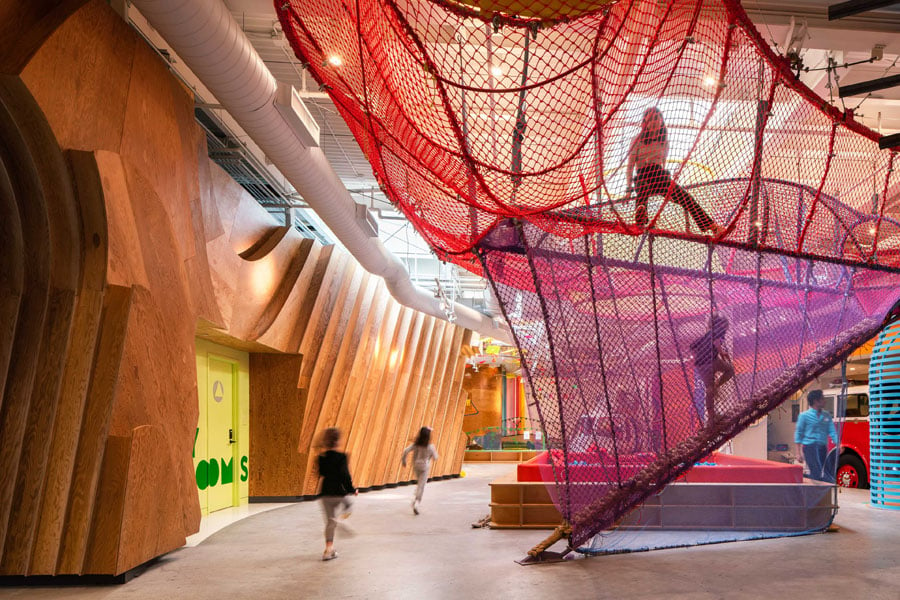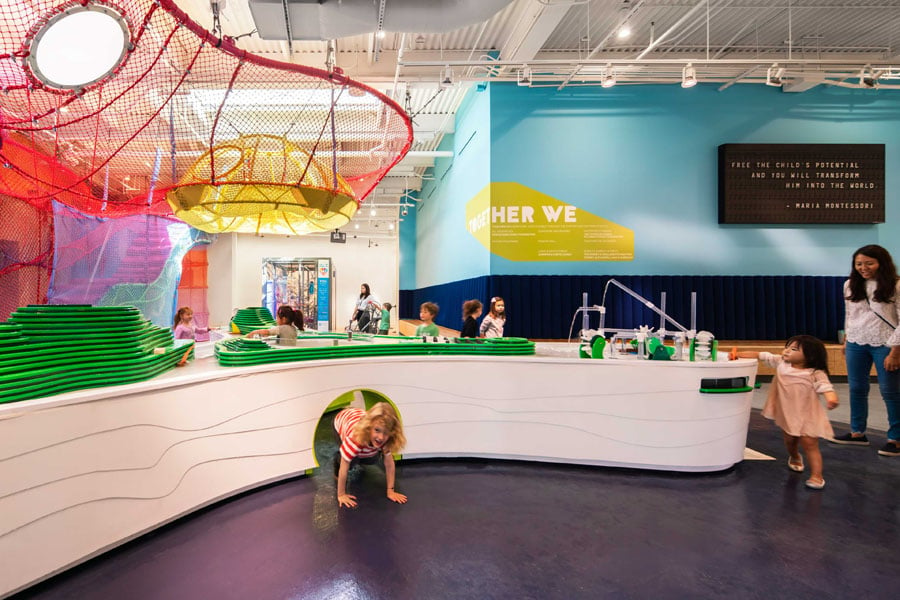
October 3, 2019
Play, Learn, Discover, Repeat: This Renovated Museum Engages Young Hearts, Hands, and Minds
OfficeUntitled imbues the new iteration of the Cayton Children’s Museum in Santa Monica with a design informed by the institution’s value-driven mission.

On a late morning weekday, decibel levels at the Cayton Children’s Museum strain tolerable levels for the noise-sensitive. Every area of the 21,000-square-foot facility located at the third level of the Santa Monica Place mall — an early Frank Gehry project that’s subsequently been reimagined to adapt to a changing retail landscape — is already teeming with activity.
A toddler runs through a strip of slim posts in various shades of green that double as as donor plaques. The concept, dubbed the Generosity Garden, evokes an abstracted forest or blades of grass, and is built to be eye-catching and durable. “Those moments, you plan for it,” Christian Robert, partner and cofounder of OfficeUntitled (formerly R&A Architecture & Design), says. It’s a design approach that applies to anything and everything that might happen in a place made for the newborn-to-10-year-old demographic.
The Cayton Children’s Museum by ShareWell, its nonprofit umbrella organization, is the second iteration of the Zimmer Children’s Museum that was founded by CEO Esther Netter thirty years ago. Its first home was a 5,000-square-foot space at the Jewish Federation of Los Angeles’s headquarters on Wilshire Boulevard. Now the institution’s mission is advanced in a fresh setting, as well as a shift from its former overt ties to Judaism to a nondenominational philosophy that makes for a more inclusive environment.
“We interviewed against another established firms and in some ways, we were the underdog,” explains OfficeUntitled partner and cofounder Shawn Gehle. Why? Because the Culver City-based firm didn’t have a completed children’s museum in its portfolio.

“We looked at it through the lens of being parents coupled with the eyes of designers, and thought about a space that would address both sides.” For research and inspiration, the team considered relevant examples of hands-on engaging learning environments that strike a balance between lightly directed and open-ended, play-centered learning, such as Kidspace in Pasadena by Michael Maltzan, along with programming at the Oregon Zoo and Meow Wolf in Santa Fe. “It gave us a chance to kick off the process with ideas,” Gehle says, and a presentation of study models the team made that immediately resonated with CEO Netter and her advisors.
“We collectively tapped into our inner children, imagined a place that would help us be our best, refrained from boundaries and the limits of adulthood, and then we just dreamed,” she recalls of the collaboration.
“Architecturally, we set it up as a free plan that could be changed or altered over time,” Gehle says. The site was formerly a large food venue, a remnant from a previous mall redesign. Gehle notes that incorporating the Cayton’s core values into the exhibits was “a very organic process” that included expert partners across multiple mediums, notably exhibition designers S2 Associates.
A few of the Zimmer’s most popular elements were carried over to the new Cayton. The repurposed Coast Guard rescue boat set in a pit full of balls was a known beloved attraction, for instance. But exhibits and design features reflect a heightened understanding and respect for children’s capacity for abstract thought and creativity. Literal installations that are essentially shrunk-down versions of the adult world (think: the market, the doctor’s office) have their place—and their limitations.
“That was the challenge,” architect Robert says. “There are certain things that you have to have, and how do you take those another step further?” The Cayton Children’s Museum offers an enticing range of interactive activities tailored to the developmental needs of specific age groups, from crawling babies, who have a dedicated section with soft surfaces and gradual height changes, to an elaborate climbing structure inspired by fiber artist Janet Echelman.
Each node is organized around the museum’s principles such as “Let’s Help,” “Together We,” “Reach For,” and “Reflect On.” So, kids jostle for a place to fly the “Help-a-copter,” or steer a firetruck against the backdrop of larger, community-focused messaging. (“Man, kids just love the experience of being able to fly something,” Gehle laughs.) Though some exhibitions have a digital, cutting-edge feel—one room projects images of butterflies that appear and flutter when the sensor registers a visitor—elements like a large art studio and central water table also emphasize analog pleasures and tactile learning. This variety and diversity boosts the appeal and makes subsequent visits all the more rewarding.

The “Hello Booth,” for example, features a room of wall-mounted old school rotary and button yellow telephones loosely based on a post-tsunami grassroots community project in Japan created to help families reunite. This corner—somewhat unwittingly—explores the tension between the designed-for-Instagram “museums” versus providing parents with “a great environment to document your kids,” Gehle observes. “From a visual standpoint, we looked at every exhibit from how it could be photographed, but not so overbearing that it takes precedence over your kids.”
Overall, the aesthetic is bold and perhaps most importantly, fun. Greg Nelson of Altitude Design Office devised a playful branding scheme and color blocked environmental graphics. Unobstructed sight lines and easy to find signage benefits kids and adults alike. High ceilings and skylights contrast with the former Zimmer, which didn’t have any natural light. Neutral plywood walls incorporate organic shapes and serve as a backdrop for the vivid color scheme used throughout. (A one-way security window incorporated into the plywood looks like a distortion mirror and evokes the shape of an armadillo to observant visitors.)
After stopping by the Grand Exit, emblazoned with a mural designed by OfficeUntitled and executed by artist Stephanie Marra, and passing through the doorway that concludes each visitor’s journey, they’re finally led to the well-curated gift shop—also the site of many a bittersweet meltdown.
You may also enjoy “The Philadelphia Museum of Art Reopens Public Spaces Hidden for Decades.”
Would you like to comment on this article? Send your thoughts to: [email protected]












